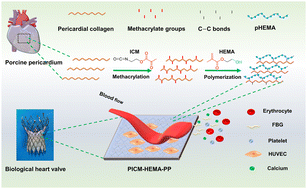A functionalized biological heart valve by double bond crosslinking with enhanced biocompatibility and antithrombogenicity†
Abstract
With the advancement of minimally invasive interventional therapy, biological heart valves (BHVs) have been extensively used in clinics. However, BHVs are generally prone to degeneration within 10–15 years after implantation due to defects including cytotoxicity, immune response, calcification and thrombosis, which are closely related to glutaraldehyde-crosslinking. In this work, we prepared a functionalized BHV through the in situ polymerization of methacrylated porcine pericardium and 2-hydroxyethyl methacrylate to avoid and overcome the defects of glutaraldehyde-crosslinked BHVs. The functionalized BHV was proven to be stable against enzymatic degradation and compatible towards HUVECs. After implantation in rats subcutaneously, a significantly mitigated immune response and reduced calcification were observed in the functionalized BHV. With the grafting of hydrophilic 2-hydroxyethyl methacrylate polymers, the antithrombogenicity of BHV was markedly enhanced by resisting the unfavorable adhesion of blood components. Moreover, the hydrodynamics of the functionalized BHV totally conformed to ISO 5840-3 under a wide range of simulated physiological conditions. These results indicate that the functionalized BHV with enhanced biocompatibility, anticalcification property and antithrombogenicity exhibited a low risk of degeneration and should be explored for further application.



 Please wait while we load your content...
Please wait while we load your content...